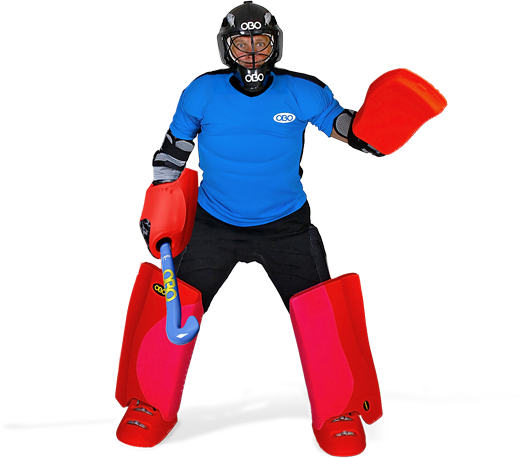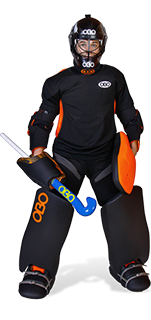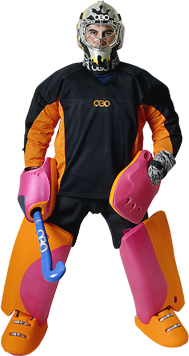KEEPERS RESOURCES

Marking the goalkeeper
 Question:
Question:
Email to the FIH: Can you please provide assistance on the following: What is the correct interpretation of a player marking the goalkeeper (standing very close and in front of) that is not in possession of the ball. As an example: A player is standing in front of the goalkeeper (standing very close and in front of) and the ball is passed to this person. My guess is using the obstruction rule and award the free hit to the defenders. But until the person receives the ball there is no offence, true? The problem as I see it (I’m an umpire, coach and goalkeeper) if the goalkeeper attempts to play the ball there is the risk of taking the player out and the goalkeeper would be penalised because he would contact the players feet and stick first before playing the ball. Also the goalkeepers vision is severely reduced because of the player in front of him prevents a legitimate tackle, as well as this the player in front is causing a situation that could lead to dangerous play by not allowing the goalkeeper to play the ball. The reason I ask this is that on the weekend my son (11 year old) was subjected to being closely marked by an attacker and the umpire responded at the end of the game that there was a new rule this year that allowed this to happen. I was playing goalkeeper when the offside rule was abolished and for a while this style of play ("Marking the goalkeeper") was the norm. These days it does not seem to be the norm, players respect the goalkeepers "space". It is worrying that young children are being coached to "mark" the goalkeeper as I myself will attempt to clear the ball no matter who is in my way (keeping within the rules) and coaches maybe failing in their duty of care, that is exposing players to an unnecessary risk. Please provide guidance on this matter, as the guidance notes for 2001-2002 are no very clear, at least to me.
Answer:
Roger Webb’s answer
Your email has been forwarded for my attention by FIH headquarters. Given the way you describe the scenario, I think the simplest and clearest way to respond is to say that an attacker in the circle has the same opportunities as a player elsewhere in the field. Thus, it is perfectly legitimate for an attacker to stand wherever they wish in the circle (without physically pushing into opponents and so on of course) – and to receive a ball facing whichever way they wish. If this happens to be near the goalkeeper, the goalkeeper must certainly NOT “take the player out” (using your words) – just as an opponent elsewhere should not “take the player out” in equivalent circumstances. The attacker receiving the ball has the same privileges wherever they stand and must be allowed to receive and play the ball without being fouled by an opponent – so a goalkeeper acting in the way you describe should be penalised very severely. I think your own view possibly therefore turns on some perceptions that I must correct. For example, you assert that “the goalkeeper’s vision is severely reduced because … the player in front of him prevents a legitimate tackle”. However, as the interpretations to the Rules explain, “the onus is on the tackler (in this example, the goalkeeper) to move into position to attempt a legitimate tackle” (see page 38 of the 2002 Rules) – so if the goalkeeper does no more than continue to stand behind the attacker they are NOT in a position to make a legitimate tackle. Further, the interpretations go on to say that “the tackler must not move bodily into the receiver and claim obstruction; such action should be firmly penalised possibly with a suspension” – hence my earlier comment about dealing very severely with a goalkeeper who “takes the player out”. I also note you say that as a goalkeeper you would “attempt to clear the ball no matter who is in (your) way keeping within the Rules”. But I hope I have shown that the sort of action you describe is NOT within the Rules! Having dealt with the Rules, it is more difficult for me to comment on whether or not coaches are encouraging attackers to stand near goalkeepers. As I have explained, it is legitimate to do so but as your experience after the withdrawal of offside indicated it is not productive – it is rarely (if ever) effective in any way. I must therefore wonder if this is the whim of an individual coach – because I have not seen this ploy used significantly in my own recent experience. I suppose whether or not a coach is failing in their “duty of care” then depends on their risking that a goalkeeper does NOT know the Rules and might, illegally, “take the player out”! I hope this explains the Rules and the interpretations that should be applied – and even though your son, as a goalkeeper, might be frustrated by such a tactic I hope he will not be tempted to respond illegally!
Jon’s answer
I’ll be honest and say I wish there was a definitive answer to your question. The scenario you described to Mr. Webb is slightly different in terms of what the keeper can do to assert his ability to play the ball than the initial scenario you explained to me. In your message to Mr. Webb, you describe: “A player is standing in front of the goalkeeper (standing very close and in front of) and the ball is passed to this person.”
The scenario where the ball is being played to this attacker is an important distinction. That is a legitimate play and tactic. With the advent of no offside, there have been a number of spectacular goals scored where forwards are making deflections in front of or behind the keeper. Play has become much more open and it requires the keeper to cover a lot more ground in defending the goal. So what can a keeper do?
Probably the easiest thing a keeper can do as Mr. Webb notes is put himself in a position to play the ball before the player in front of him. Just as the attacker has a right to play anywhere he wants in the circle, so does the keeper. If an attacker is going to stand in front of a keeper, the keeper has the same right to stand in front of him. Rather than tackle the attacker, the keeper is looking to intercept. As I alluded to in my first reply, this usually results in a game of musical chairs/argy bargy as the attacker and the keeper jostle for position. A keeper has to beware of being pulled off his line and passed around, but depending on your opponent, it might be a tactic you have to use.
My interpretation of your initial e-mail was one where the attacker is in front of the keeper with no intention of playing the ball. His intent is to screen/distract the keeper. I’ve received several e-mails on the topic and I’ve seen coaches tell their players to “get on the keeper.” Typically it’s been at lower levels of play. Either way, that tactic reflects a disregard of the rules and sportsmanship. I’ve rarely seen goals scored when the player is just standing in front of the keeper and far more often, I’ve seen the attacker get hit with the ball as it goes to goal.
As evidenced by your experience with replies, there are a variety of answers to your question. The biggest variables your situation presents are perspective and interpretation, both highly subjective. An umpire is going to have a hard time blowing intent, especially if he’s only seeing a small segment of the play. Thanks for forwarding on Mr. Webb’s reply, I’m sure this won’t be the last we’ll hear of these types of situations. Hopefully with discussion, we’ll at least achieve clarification.
Comments
Leave Your Comments Below
















































